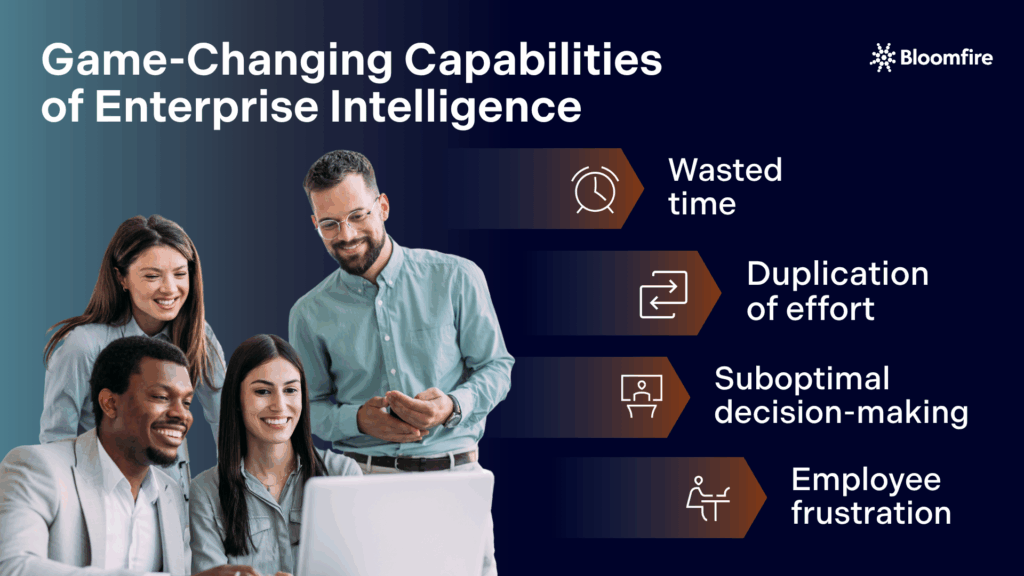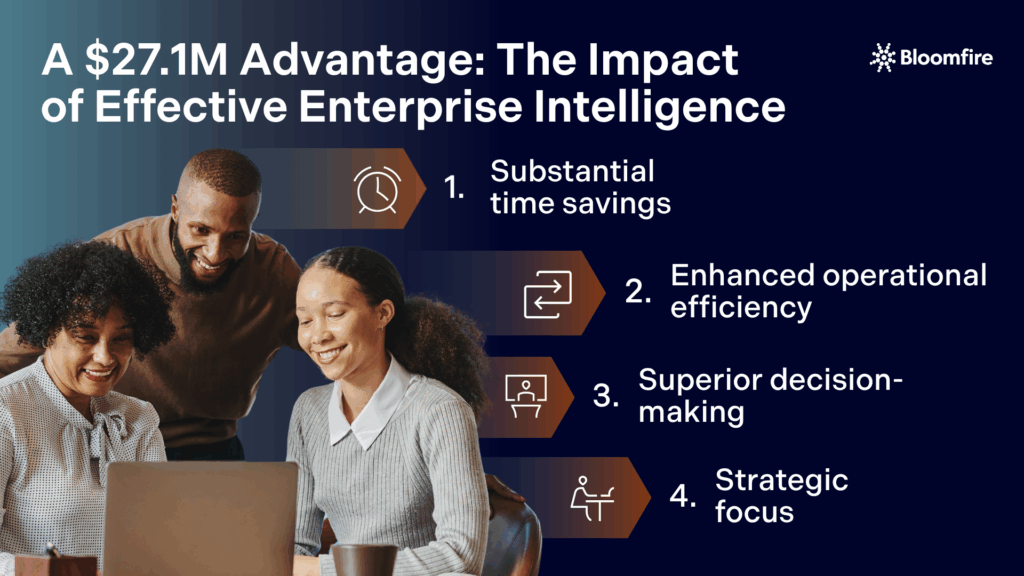Maximizing Knowledge Assets: The Financial Value of Enterprise Intelligence

What’s your organization’s most undervalued asset? It’s likely not on your balance sheet, nor is it a physical property. It’s the knowledge residing within your enterprise–the data, insights, expertise, documents, and processes that fuel every decision and innovation. This collective intelligence, often intangible, holds immense financial value.
Many companies, however, are sitting on a goldmine they’ve yet to fully exploit. The key to unlocking this potential lies in a strategic approach that transforms raw information into actionable insights, revealing the profound business value of Enterprise Intelligence.
This discussion will explore how Enterprise Intelligence can unlock this hidden value, revealing tangible financial gains that can put your knowledge assets to work and have a profound impact on your bottom line.
The Hidden Cost of Dispersed Knowledge Assets
Organizations are awash in information. This critical data is frequently scattered across a dizzying array of systems: customer relationship management systems (CRMs), enterprise resource planning systems (ERPs), shared drives, individual desktops, internal wikis, and more. Its fragmentation creates a significant, often invisible, drain on productivity and, ultimately, profitability.
Consider this insight: Companies with five or more knowledge sources experience the most significant productivity loss. You can have a glimpse of this reality from an employee’s daily grind. They need a piece of information, and the search begins. They navigate multiple systems, recall various login credentials, and sift through countless files. It’s a digital scavenger hunt, and it’s costing you. This dispersion leads to:
- Wasted time: Precious hours are lost daily as employees hunt for information that should be instantly accessible.
- Duplication of effort: Teams unknowingly recreate work because existing resources are undiscoverable.
- Suboptimal decision-making: Incomplete or outdated insights lead to costly errors and missed opportunities.
- Employee frustration: Nothing erodes morale and engagement more than constant roadblocks to completing work.
These silent drains don’t appear as line items on your P&L (profit and loss statement), but their cumulative impact on your financial health is undeniable. This often manifests as reduced efficiency, missed opportunities, and increased operational costs that erode profitability over time.
Why Enterprise Intelligence Is a Financial Game-Changer
How do you transform this challenge into a decisive competitive advantage? The answer lies in Enterprise Intelligence. More than just a tool, Enterprise Intelligence is a strategic approach that integrates, analyzes, and makes accessible your organization’s collective knowledge. It directly tackles the inefficiencies that plague modern enterprises, turning knowledge from a cost center into a profit driver. It does so through these capabilities.

- Unified search: Providing a single, intuitive interface to search across all your disparate knowledge sources. This dramatically cuts down the time to insight, by reducing the barriers to information access by as much as 59%, freeing up valuable employee time.
- Intelligent content categorization: Automatically organizing and tagging information, making it effortlessly discoverable. It not only improves efficiency but also ensures that critical, often overlooked, data is surfaced when needed.
- Semantic understanding: Grasping the meaning behind the data, not just keywords, to deliver highly relevant results. This precision in information retrieval means employees receive the correct answers more quickly, leading to faster problem-solving and decision-making.
- Personalized insights: Delivering tailored information to employees based on their roles, projects, and immediate needs. Enterprise Intelligence doesn’t just retrieve documents; it delivers the right information at the right time, understanding the user’s intent and the context of their work.
- Automated Discovery: Leveraging advanced artificial intelligence (AI), Enterprise Intelligence proactively surfaces relevant insights, often before an employee even realizes they need them.
In essence, Enterprise Intelligence transforms your scattered knowledge into actionable, accessible, and, most importantly, financially valuable assets. It’s about rewiring how companies operate, leading to fundamental shifts in cost structures and revenue streams. It combines the financial impact of knowledge management, enterprise search, and business intelligence.
For a Fortune 500 company, inefficient knowledge management can impact up to 25% of annual revenue, translating to approximately $2.4 billion in enterprise value at risk. Enterprise Intelligence directly addresses this by making knowledge a strategic asset that drives measurable improvements across the board.
Source for statistics: “The Value of Enterprise Intelligence” report by Bloomfire.
The $27.1M Advantage of Enterprise Intelligence
The financial impact of effective Enterprise Intelligence is not theoretical; it’s profound and quantifiable. Our report indicates that Enterprise Intelligence delivers a $27.1M productivity impact per 100 employees annually. Let’s unpack this significant figure.

1. Substantial time savings
Imagine if every employee could reclaim just 30 minutes a day previously spent searching for information. Over the course of a year, for every 100 employees, that translates into thousands of hours redirected from unproductive searching to value-generating work.
Employees without efficient knowledge systems lose more than 20% of their week searching for information. However, companies can save 203 hours per employee annually through AI-powered knowledge management systems.
2. Enhanced operational efficiency
Projects accelerate, problems are resolved faster, and the need for redundant research diminishes. This directly translates into reduced operational costs and improved throughput.
For instance, a U.S.-based confectionery company’s marketing department recognized $1.6 million in efficiencies by recovering time spent searching for needed insights. Similarly, a third-party logistics provider generated $778,650 in savings by reducing onboarding time by two-thirds, thanks to improved access to knowledge assets.
3. Superior decision-making
When employees have immediate access to comprehensive, accurate insights, they make better, more informed decisions. These optimized decisions lead to higher revenue, fewer costly errors, and significantly mitigated risks.
Companies with strong knowledge management programs have seen a 31% increase in decision-making speed and a 36% improvement in decision accuracy. A regional banking institution generated $15.6 million in revenue by helping employees quickly and effortlessly find the inputs they needed using their knowledge management program.
4. Strategic focus
Employees can dedicate more of their intellect and energy to high-value, strategic tasks that directly contribute to business growth and innovation by eliminating the search tax. This increased workforce capacity can be equivalent to adding 98 full-time equivalents (FTEs) per 1,000 employees, representing a 9.8% increase in workforce capacity without additional hires.
The Broader Financial Upside Beyond Productivity
The full benefits of enterprise intelligence go beyond efficiency. While productivity gains are a primary driver, Enterprise Intelligence offers a cascade of additional financial advantages that contribute to long-term competitive advantage:
- Accelerated innovation: Faster access to existing research, market trends, and internal ideas significantly shortens the innovation cycle, leading to quicker product development and market entry.
- Reduced risk and enhanced compliance: Ensuring employees have immediate access to the latest policies, regulations, and best practices helps mitigate risks and ensures compliance, preventing potential fines or legal liabilities.
- Elevated customer experience: Empowered customer service teams, armed with instant access to comprehensive customer histories and product knowledge, can resolve issues faster and more accurately, leading to higher customer satisfaction and retention.
- Improved employee retention: A more efficient and less frustrating work environment, where employees feel empowered by accessible knowledge, significantly boosts job satisfaction and reduces costly turnover.
These benefits underscore that Enterprise Intelligence is far more than just an operational improvement. They tell you how much it has become a strategic investment that fortifies an organization’s competitive posture and fosters a culture of continuous learning. More importantly, it contributes to sustainable growth and profitability across all key business functions by imposing cost savings from knowledge platforms that are limited to static functions.
Frequently Asked Questions
What is the difference between knowledge management and enterprise intelligence?
While knowledge management (KM) traditionally focuses on creating, storing, and sharing knowledge within an organization, Enterprise Intelligence transforms static knowledge into dynamic intelligence that directly drives business outcomes. It leverages advanced technologies like AI and machine learning to not only manage knowledge as an asset but also to actively analyze, connect, and deliver highly relevant and actionable insights across the entire enterprise.
How do you measure the ROI of Enterprise Intelligence?
Measuring the ROI of Enterprise Intelligence involves quantifying both direct and indirect benefits. Key metrics include reduced time for searching information, enhanced operational efficiency through faster task completion and streamlined onboarding, improved decision-making leading to quantifiable impacts on revenue, reduced errors, and mitigated risks.
Additionally, benefits include elevated customer satisfaction through higher first-contact resolution rates, improved employee retention due to increased job satisfaction, and accelerated innovation that shortens time-to-market for new products. These tangible and intangible gains are then weighed against the investment in Enterprise Intelligence solutions to determine the overall return.
How do you build a business case for investing in enterprise intelligence?
Building a robust business case for Enterprise Intelligence requires demonstrating a clear link between Enterprise Intelligence and tangible financial outcomes. Start by documenting existing costs based on dispersed knowledge and quantifying potential gains to project savings and revenue. Then, articulate how it will enhance strategic advantages, culminating in a comprehensive ROI analysis that highlights both quantitative and qualitative benefits.
Enterprise Intelligence as a Strategic Imperative
Investing in Enterprise Intelligence isn’t merely about incremental efficiency gains; it’s about realizing the full financial potential of your organization’s most valuable, yet often underutilized, asset: its knowledge. Systematically transforming fragmented information into a cohesive, accessible, and intelligent resource enables your company to unlock substantial productivity gains, accelerate innovation, mitigate risk, and ultimately, achieve significant financial returns.
Is your organization ready to stop leaving millions on the table and start harnessing the full potential of its Enterprise Intelligence? Speak to our expert.
Maximize Your Profits!
Capitalize on the advantages of Enterprise Intelligence to improve your bottom line.
Learn More

How to Improve Customer Service in Call Centers: 21 Ways to Enhance Contact Center Experience

Innovative Ways Companies Are Using Knowledge Management

How to Implement a Knowledge Check in 6 Steps

Estimate the Value of Your Knowledge Assets
Use this calculator to see how enterprise intelligence can impact your bottom line. Choose areas of focus, and see tailored calculations that will give you a tangible ROI.

Take a self guided Tour
See Bloomfire in action across several potential configurations. Imagine the potential of your team when they stop searching and start finding critical knowledge.
